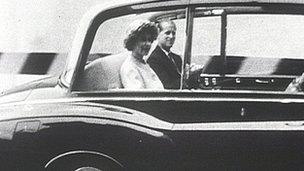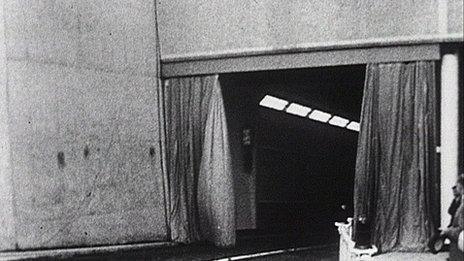Princess Royal marks Clyde Tunnel's 50th anniversary
- Published
It took seven years to complete, cost £10m to build and claimed the lives of two men in the construction process.
In an era before mass car ownership, the Clyde Tunnel in Glasgow was designed to handle around 9,000 vehicles a day when it was opened by the Queen in 1963.
Half a century on, the Princess Royal visited Glasgow to celebrate the 50th anniversary of the opening at a time when 65,000 vehicles use the tunnel on a daily basis - the same amount of traffic as uses the Forth Road Bridge.
And while the tunnel is considered to be a modern-day engineering triumph, the reality is that the techniques used in its construction were a throwback to Victorian times.
Journalist Peter Ross, who has written about the tunnel, said: "They demolished 250 tenements, a church, several bowling greens and some allotments.
"When work began in 1957 they used compressed air and hand tools. If you look at old photographs it looks Victorian. It's men in flat caps and vests, covered in mud and sweat and they are digging it out with shovels and picks using Victorian technology."
He added: "It was really tough work. They got through between nine and 30ft a day whereas using today's technology they'd get through 250ft a day."
Financial difficulties
The idea to build a crossing under the river was not new. The Harbour Tunnel at Finnieston was built in the 1890s.
But the Clyde Tunnel project was a much larger and more ambitious project. The scheme was approved in 1948 but financial difficulties prevented work from beginning for almost a decade.
Peter Ross said: "It was planned as part of the great post-war dream of the new Glasgow of the future at the same time as they were knocking down tenements and building high rises and housing schemes."
The plan was to deal with congestion caused by traffic on the existing bridges. There was no scope to build another bridge as it would have interfered with shipping on the Clyde.
The finished structure is in fact not just one tunnel.
Peter explains: "It's essentially a big, cast iron tube divided into four parts - one northbound, one southbound plus pedestrian and cycle ways underneath."
The half-mile crossing, which is sealed with lead, runs 21ft beneath the river - between Whiteinch and Govan.
A team of around 16 miners worked on the construction, removing hard rock by hand under a soft layer beneath the river.
A tunnelling shield, based on Marc Isambard Brunel's design used for the Thames Tunnel a century earlier, was used.
The tunnels were cut perfectly circular with the road deck sitting a third of the way up.
The miners operated the shield working shifts in a compressed air environment to ensure the rock and the river above did not collapse into the tunnelling area. The digging itself involved a high degree of difficulty due to the geology of the area which featured hard rock sitting under a soft silt layer beneath the river.
The techniques for decompression after a period of working in a high pressure atmosphere had not been perfected when the work was being carried out.
And some workers refused to subject themselves to the decompression sequence given the length of time required, around an hour.
As a result there were a number of cases of decompression sickness which resulted in two fatalities.
In fact, signs were put up in Govan Road advising local residents that any man seen staggering may not in fact be drunk but may be a construction worker suffering from the bends.
Other problems were encountered and on one occasion work came to a stop after an explosion when compressed air escaped through the tunnel lining into the river.
The tunnels are each 762m (2500ft) long with a gradient approaching 6% or 1:16. The width of the river at this point is 123m (404ft). Each road tunnel carries two lanes of traffic as part of the A739 road.
The first completed tunnel tube, for northbound traffic, was eventually opened by the Queen on July 3 1963, with the southbound tunnel opening in March 1964.

The Queen and Duke of Edinburgh at the opening ceremony
The total cost of the project was £10m.
Initially, the estimate for traffic levels was between 9,000 and 13,000 vehicles per day. But on opening day 22,000 vehicles used the tunnel. Now, with 65,000 vehicles a day, 25 million vehicles use it every year.
The control room on the north side of the river is manned by staff who operate the lighting, ventilation, sumps and pumps and control the flow of traffic.
They also have other duties including keeping alert for claustrophobic motorists who have been known to panic and suddenly slam their car into the walls.
The most common breakdown problem is cars running out of petrol.
But there have been unusual accidents.
Peter Ross recalls: "There was one occasion when a very old woman got very confused and tried to drive her Volkswagen Golf into the pedestrian tunnel and it actually got jammed in the walkway, part of the way down."
Despite its functional appearance, Peter enthuses as he talks about the tunnel.
He said: "It's a very peculiar mix. The Clyde Tunnel is an incredible feat of masculine engineering muscle but there's a feminine beauty to the tunnel.
"And there is the great whimsy of the idea of going underneath the water. There's a great game children play where they go into the tunnel in the car with mum and dad and try to hold their breath in the back seat.
"It takes about a minute at 30mph. It's achievable - but when you get stuck in a jam it's much more of a challenge."

Curtains part to open the tunnel 0n July 3 1963
At 50-years-old the tunnel has undergone extensive repair work over the years.
The most expensive project involved the installation of a secondary lining incorporating the latest fire protection materials. That cost £12m - £2m more than the original construction work.
The tunnel is expected to continue in use while remaining as a remarkable Glasgow landmark for many years to come.
Peter said: "I'm sure in 2063, we'll be celebrating the centenary and there will be Glasgow children on jetpacks trying to hold their breath as they go through it then.
"At heart, it's a piece of Victorian engineering, built in in the 20th century and it's going to last into the 22nd century for all I know."